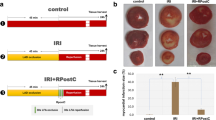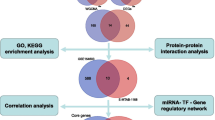Abstract
Air pollution has been a major environment-related health threat. Most of the studies on PM2.5 toxicity have verified on the cardiovascular system and endothelial cells. However, researches on PM2.5-induced myocardial-related toxicity are limited. This study aims to fully understand the toxic effects of PM2.5 on human myocardial cell (AC16) and explore its molecular mechanism based on microarray analysis and bioinformatics analysis. Microarray data analysis manifested that PM2.5-induced toxicity affected expression of 472 genes compared with the control group, including 166 upregulated genes and 306 downregulated genes in human myocardial (AC16) cells. GO analysis showed that cellular processes such as immune response, cell maturation, embryonic heart tube morphogenesis, cellular response to electrical stimulus, skeletal muscle tissue regeneration, and negative regulation of signal transduction were upregulated, while regulation of transcription (DNA-dependent), rhythmic process, protein destabilization apoptotic process, and innate immune response were downregulated. The pathway analysis indicates that cell signaling pathways such as cytokine-cytokine receptor interaction, NF-κB signaling pathway, chemokine signaling pathway, endocrine and other factor-regulated calcium reabsorption, HTLV-I infection, and cell adhesion molecules (CAMs) were upregulated, while the TGF-β signaling pathway was downregulated. In addition, Signal-net showed that the TUBA4A, ADRBK2, BRIX1, SMC4, EIF5B, PRMT1, ATG4B, and NDC80 genes were significantly decreased, while the expression of the KRT6B gene was markedly increased compared with the control group. All the genes were verified by qRT-PCR. This study had provided new bioinformatics evidences in PM2.5-induced myocardial tissue toxicity which is necessary for further cardiovascular system toxicity studies.






Similar content being viewed by others
References
Brook RD, Rajagopalan S, Pope CA et al (2010) Particulate matter air pollution and cardiovascular disease: an update to the scientific statement from the American Heart Association. Circulation 121:2331–2378
Cao XN, Yan C, Liu DY et al (2015) Fine particulate matter leads to reproductive impairment in male rats by overexpressing phosphatidylinositol 3-kinase (PI3K)/protein kinase B (Akt) signaling pathway. Toxicol Lett 237:181–190
Chafe ZA, Brayer M, Klimont Z et al (2014) Household cooking with solid fuels contributes to ambient PM2.5 air pollution and the burden of disease. Environ Health Perspect 122:1314–1320
Chi GC, Liu Y, MacDonald JW et al (2016) Long-term outdoor air pollution and DNA methylation in circulating monocytes: results from the Multi-Ethnic Study of Atherosclerosis (MESA). Environ Health 15:119
Dai L, Bind MA, Koutrakis P et al (2016) Fine particles, genetic pathways, and markers of inflammation and endothelial dysfunction: analysis on particulate species and sources. J Expo Sci Environ Epidemiol 26:415–421
Duan J, Yu Y, Li Y et al (2017) Comprehensive understanding of PM2.5 on gene and microRNA expression patterns in zebrafish (Danio rerio) model. Sci Total Environ 17:30283–30288
GBD 2013 Risk Factors Collaborators (2015) Global, regional, and national comparative risk assessment of 79 behavioural, environmental and occupational, and metabolic risks or clusters of risks in 188 countries, 1990–2013: a systematic analysis for the Global Burden of Disease Study 2013. Lancet 386:2287–2323
Giorgini P, Di Giosia P, Grassi D et al (2016) Air pollution exposure and blood pressure: an updated review of the literature. Curr Pharm Des 22:28–51
Gold DR, Litonjua A, Schwartz J et al (2000) Ambient pollution and heart rate variability. Circulation 101:1267–1273
He C, Zhu H, Zhang W et al (2013) 7-Ketocholesterol induces autophagy in vascular smooth muscle cells through Nox4 and Atg4B. Am J Pathol 183:626–637
Hu H, Wu J, Li Q et al (2016) Fine particulate matter induces vascular endothelial activation via IL-6 dependent JAK1/STAT3 signaling pathway. Toxicol Res 5:946–953
Kanehisa M, Goto S, Kawashima S et al (2004) The KEGG resource for deciphering the genome. Nucleic Acids Res 32:D277–D280
Kim JY, Lee EY, Choi I et al (2015) Effects of the particulate matter2.5 (PM2.5) on lipoprotein metabolism, uptake and degradation, and embryo toxicity. Mol Cells 38:1096–1104
Li C, Li H (2008) Network-constrained regularization and variable selection for analysis of genomic data. Bioinformatics 24:1175–1182
Lim SS, Vos T, Flaxman AD et al (2012) A comparative risk assessment of burden of disease and injury attributable to 67 risk factors and risk factor clusters in 21 regions, 1990-2010: a systematic analysis for the Global Burden of Disease Study 2010. Lancet 380:2224–2260
Martinelli N, Olivieri O, Girelli D (2013) Air particulate matter and cardiovascular disease: a narrative review. Eur J Intern Med 24:295–302
McGuinn LA, Ward-Caviness CK, Neas LM et al (2016) Association between satellite-based estimates of long-term PM2.5 exposure and coronary artery disease. Environ Res 145:9–17
Morales Y, Nitzel DV, Price OM et al (2015) Redox control of protein arginine methyltransferase 1 (PRMT1) activity. J Biol Chem 290:14915–14926
Nelin TD, Joseph AM, Gorr MW et al (2012) Direct and indirect effects of particulate matter on the cardiovascular system. Toxicol Lett 208:293–299
Nemmar A, Holme JA, Rosas I et al (2013) Recent advances in particulate matter and nanoparticles toxicology: a review of the in vivo and in vitro studies. Biomed Res Int 2013:279371
Park SK, Auchincloss AH, O'Neill MS et al (2010) Particulate air pollution, metabolic syndrome, and heart rate variability: the multiethnic study of atherosclerosis (MESA). Environ Health Perspect 118:1406–1411
Pinsino A, Russo R, Bonaventura R et al (2015) Titanium dioxide nanoparticles stimulate sea urchin immune cell phagocytic activity involving TLR/p38 MAPK-mediated signaling pathway. Sci Rep 5:14492
Pope CA, Muhlestein JB, May HT et al (2006) Ischemic heart disease events triggered by short-term exposure to fine particulate air pollution. Circulation 114:2443–2448
Rui W, Guan L, Zhang F et al (2016) PM2.5-induced oxidative stress increases adhesion molecules expression in human endothelial cells through the ERK/AKT/NF-κΒ-dependent pathway. J Appl Toxicol 36:48–59
Schneider A, Hampel R, Ibald-Mulli A et al (2010) Changes in deceleration capacity of heart rate and heart rate variability induced by ambient air pollution in individuals with coronary artery disease. Part Fibre Toxicol 7:29
Timonen KL, Vanninen E, de Hartog J et al (2006) Effects of ultrafine and fine particulate and gaseous air pollution on cardiac autonomic control in subjects with coronary artery disease: the ULTRA study. J Expo Sci Environ Epidemiol 16:332–341
Wang X, Chen M, Zhong M, et al (2017) Exposure to concentrated ambient PM2.5 shortens lifespan and induces inflammation-associated signaling and oxidative stress in drosophila. Toxicol Sci 156(1):199–207
Weichenthal S (2012) Selected physiological effects of ultrafine particles in acute cardiovascular morbidity. Environ Res 115:26–36
Weichenthal S, Lavigne E, Evans G et al (2016) Ambient PM2.5 and risk of emergency room visits for myocardial infarction: impact of regional PM2.5 oxidative potential: a case-crossover study. Environ Health 15:46
Xie Y, Gong C, Bo L et al (2015) Treg responses are associated with PM2.5-induced exacerbation of viral myocarditis. Inhal Toxicol 27:281–286
Xing XK, Xu CS (2010) Functions of Ndc80 complex in outer kinetochore. Chinese Journal of Zoology 45:176–180
Yi M, Horton JD, Cohen JC et al (2006) Whole pathway scope: a comprehensive pathway-based analysis tool for high-throughput data. BMC Bioinformatics 7:30
Zhang JD, Wiemann S (2009) KEGGgraph: a graph approach to KEGG PATHWAY in R and bioconductor. Bioinformatics 25:1470–1471
Zhang H, Yao Y, Chen Y et al (2016) Crosstalk between AhR and wnt/β-catenin signal pathways in the cardiac developmental toxicity of PM2.5 in zebrafish embryos. Toxicology 355-356:31–38
Zheng GJ, Duan FK, Ma YL et al (2015) Exploring the severe winter haze in Beijing: the impact of synoptic weather, regional transport and heterogeneous reactions. Atmospheric Chemistry & Physics 15:2969–2983
Acknowledgements
This work was supported by the National Natural Science Foundation of China (81571130090, 81230065, 81673204), Special Project of Beijing Municipal Science & Technology Commission (KZ201410025022), and Scientific Research Common Program of Beijing Municipal Commission of Education (KM201610025006). The authors thank Weiping Tang of Cnkingbio for bioinformatics assistance.
Author information
Authors and Affiliations
Corresponding authors
Ethics declarations
Conflict of interest
The authors declare they have no conflict of interest.
Additional information
Responsible editor: Philippe Garrigues
Rights and permissions
About this article
Cite this article
Feng, L., Yang, X., Asweto, C.O. et al. Genome-wide transcriptional analysis of cardiovascular-related genes and pathways induced by PM2.5 in human myocardial cells. Environ Sci Pollut Res 24, 11683–11693 (2017). https://doi.org/10.1007/s11356-017-8773-3
Received:
Accepted:
Published:
Issue Date:
DOI: https://doi.org/10.1007/s11356-017-8773-3




